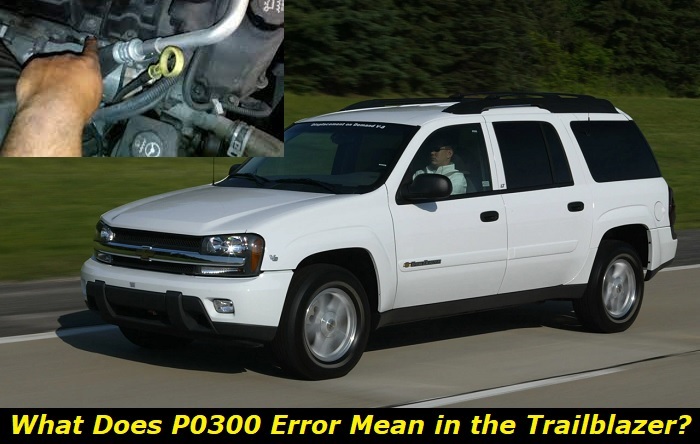Sometimes, it can be such a pain to diagnose various fault codes in vehicles, especially if they relate to numerous components. One of them is the P0300 in the Chevy Trailblazer which can range from engine to electrical parts failure.
P0300 code highlights
- Level of urgency:Medium
- Possible culprits:Bad plugs, bad coils, issues with fuel supply, air supply problems
- Price for repair:$100 - $550
- If neglected:Loss of power, harsh work, inefficient fuel consumption, vibrations
- DIY repairs:Possible but complicated
- Can you drive?Yes

What is the P300 Fault Code in the Chevy Trailblazer
The P0300 engine code relates to a cylinder misfiring issue. This occurs when not enough fuel is burned in the engine or the spark plug is damaged. Extreme weather conditions can also harm your car's catalytic converter. In the case of a Chevy Trailblazer, some common causes of this fault code may range from electrical to mechanical issues.
Ignoring the issue can result in further damage to your Trailblazer's engine or catalytic converter. It could lead to decreased fuel efficiency and increased emissions from your vehicle, and you might experience inconsistent performance with it due to the misfiring issue.
It is therefore important to address this problem as soon as possible to prevent more serious problems down the line from parts failure.
Think that modern Trailblazer is more reliable? Read our article about the 1.2L engine and its problems.
Most Common Factors Triggering the P0300 Fault Code in the Chevy Trailblazer
Diagnosing the P0300 fault code can sometimes get a bit tricky because of the different elements that could possibly trigger the issue. As mentioned earlier, these can range from electrical to mechanical problems.
In the case of the Chevy Trailblazer, we have streamlined all the most common contributors to the issue for your easy reference. These include the following:
1. Sensor and Wiring Issue
Based on customer complaints, it appears that the most common causes of the P0300 fault code in the Chevy Trailblazer are sensor and wiring issues. They usually stem from one or a combination of dirty or bad sensors monitoring the camshaft, airflow, oxygen, or throttle position, as well as their respective connections.
The ensuing mayhem may force the engine to misfire, activate the check engine light, and make the vehicle produce an irregular idle.
To diagnose these issues, begin with a visual inspection of all related components such as sensors, hoses, connectors, wiring harnesses, and so forth. Check for loose or disconnected vacuum lines or electrical connections that can disrupt the signals from the sensors. If there are any problems present, replace them promptly and ensure they are properly reconnected.
Next, use a scan tool to read each sensor's data stream to determine if it is within acceptable parameters. For example, if an O2 sensor is providing erratic data and triggering a lean condition in one cylinder but not others, then it's likely faulty or contaminated.
Replace the oxygen sensor to resolve this issue. Conduct the same test for the other sensors mentioned earlier, and conduct the appropriate corrective action to solve the problem.
You can also use a scope to check for electrical dropouts or interference with the wiring harness. If necessary, you can use an ohmmeter to measure resistance in any cables or sensors to determine which ones are causing problems.
Be sure to thoroughly clean any dirt and debris from its connectors before reinstalling it to avoid any further issues. Should you have trouble locating or fixing the issue, don't hesitate to ask for assistance from a certified car technician.
2. Defective ECU
Another common cause of the P0300 can be as easy as a glitching engine control unit (ECU). The ECU controls many aspects of the engine such as fuel injection and timing. When it is malfunctioning, it can cause a misfire in multiple cylinders, thus triggering the P0300 fault code.
Diagnosing an ECU problem initially requires inspecting all hardware components connected to it. This may include cables, plugs, wires, and other related parts. If there are broken or worn-out ones, these should be replaced immediately with new ones that are compatible with the vehicle's specifications.
All software issues must also be taken into account when diagnosing an ECU-related issue. The most common solution for this is reflashing the computer so that all its settings return to factory defaults or are patched within the recommended calibration of Chevrolet.
This might help solve erratic behavior caused by incorrect coding. However, if this does not work due to possible hardware damage, a new ECU might be needed to replace the old one.
3. Fouled or Burnt Fuse
When diagnosing a possible problem with the fuse that may be triggering the P0300 fault code in the Chevy Trailblazer, it is essential to conduct a visual inspection of the fuse itself and any other related components. A visual inspection can reveal a corroded or otherwise damaged connection, as well as structural damage caused by heat, vibration, or age.
If there are signs of wear and tear on the fuse or its connections, then it should be replaced immediately. Moreover, if you notice that the metallic part of the fuse has changed color from silver to black, this indicates that internal arcing has occurred and needs to be addressed before further damage occurs.
To further determine if a faulty fuse is causing the P0300 fault code, you can use a multimeter to measure the resistance across the fuse's connections. If it registers as open or infinite, then this indicates that there is indeed an issue with the fuse and it needs to be replaced. If you are having difficulty accessing the fuse box or removing the faulty fuse, professional tools may be necessary to prevent damaging other parts of the vehicle.
Once you have determined that a burnt or fouled fuse is causing the P0300 fault code in your Chevy Trailblazer, you need to replace it as soon as possible. You should also inspect any related components for additional signs of damage before completing repairs.
Replacing a burnt or fouled fuse is fairly straightforward and can typically be done without needing to replace any other parts. Furthermore, it is recommended to replace the fuse with one of the same size and type to ensure compatibility and avoid any potential electrical issues in the future.
It is also important to note that a burnt or fouled fuse may be caused by an issue with another part or system in your vehicle, such as an alternator or battery. In these cases, further diagnostics should be conducted to determine the underlying cause before replacing the fuse. This can help prevent additional damage and preserve the longevity of your vehicle.
4. Various Mechanical Issues
Now comes the most complicated part, and that is diagnosing the possible mechanical problems that may be contributing to the P0300 fault code. As discussed earlier, the warning directly points to a cylinder misfire.
In reality, though, a cylinder misfire can be due to a lot of things. In the Chevy Trailblazer, this can be due to a damaged spark plug, ignition timing problem, vacuum leak, worn distributor cap, malfunctioning ignition coil, catalytic converter failure, clogged EGR, head gasket leak, faulty Fuel Injector, and/or a damaged engine cylinder.
The symptoms associated with each of these problems will often vary, but they can include harsh engine vibrations, engine overheating, power loss, and reduction in fuel efficiency. The most common symptom is a ticking noise that comes from the cylinder head.
To fix the problem, you'll need to identify which component is not functioning properly. If it's something like a spark plug or distributor cap problem, then replacing them may be the best option. On the other hand, if it's an ignition coil issue then cleaning and re-gapping might be necessary. Similarly, if there is a vacuum leak then it needs to be identified and patched adequately.
It all depends on how severe the issue is and what part has caused it so the best approach is to take your vehicle to a professional mechanic who can diagnose the problem accurately and determine which component needs cleaning or replacing. With the right diagnosis and repairs, you should be able to get rid of the P0300 fault code and have your Chevy Trailblazer back on the road in no time.
Conclusion
If left unaddressed for too long, the P0300 fault code may lead to more serious mechanical problems like permanent engine damage. Therefore, it's important that you address this issue as soon as possible.
A proper diagnosis will allow you to identify exactly what part has gone wrong so that you can take the necessary steps toward solving it. With regular maintenance, these problems are usually quite easy to fix, but if they are left unattended, they can cause serious and expensive damage. If you suspect that your vehicle is suffering from a P0300 fault code, it's best to take it in for inspection as soon as possible.
It's also important to be mindful of the signs and symptoms associated with each problem so that you can quickly diagnose any similar issues in the future. This will help you fix them before they cause more costly damage. With proper diagnosis and repair, you should be able to get your Chevy Trailblazer back on track again.
By following these steps, you can keep yourself safe on the road while ensuring your vehicle remains in good condition for a long time to come. So, don't wait until it's too late. Take the necessary steps right away to avoid serious consequences down the line.
About the authors
The CarAraC research team is composed of seasoned auto mechanics and automotive industry professionals, including individuals with advanced degrees and certifications in their field. Our team members boast prestigious credentials, reflecting their extensive knowledge and skills. These qualifications include: IMI: Institute of the Motor Industry, ASE-Certified Master Automobile Technicians; Coventry University, Graduate of MA in Automotive Journalism; Politecnico di Torino, Italy, MS Automotive Engineering; Ss. Cyril and Methodius University in Skopje, Mechanical University in Skopje; TOC Automotive College; DHA Suffa University, Department of Mechanical Engineering






Add comment